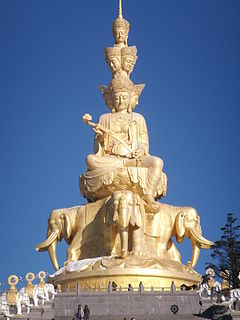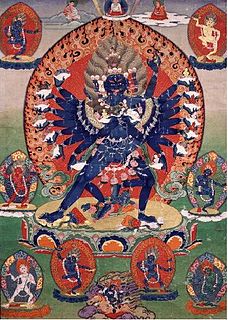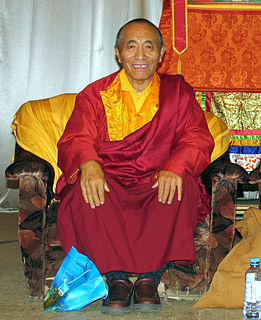Samten Migdrön (Tibetan : བསམ་གཏན་མིག་སྒྲོན, Wylie : bsam gtan mig sgron; alternate nomenclature Wylie : rnal 'byor mig gi bsam gtan) is a Tibetan text of historical importance for the historical relationship of Dzogchen and Zen as well identifying the view of its author, Nubchen Sangye Yeshe.

The Tibetan alphabet is an abugida used to write the Tibetic languages such as Tibetan, as well as Dzongkha, Sikkimese, Ladakhi, and sometimes Balti. The printed form of the alphabet is called uchen script while the hand-written cursive form used in everyday writing is called umê script.

The Wylie transliteration scheme is a method for transliterating Tibetan script using only the letters available on a typical English language typewriter. It bears the name of Turrell V. Wylie, who described the scheme in an article, A Standard System of Tibetan Transcription, published in 1959. It has subsequently become a standard transliteration scheme in Tibetan studies, especially in the United States.

Dzogchen or "Great Perfection", Sanskrit: अतियोग, is a tradition of teachings in Tibetan Buddhism aimed at discovering and continuing in the natural primordial state of being. It is a central teaching of the Nyingma school of Tibetan Buddhism and of Bon. In these traditions, Dzogchen is the highest and most definitive path of the nine vehicles to liberation.
Contents
- The Total Sphere in Six Aspects
- Extract and English rendering
- Commentary
- See also
- References
- Further reading
Namkhai Norbu et al. (1986: p. 23) identify Nubchen Sangye Yeshe as the author of a treatise, Samten Migdrön (Tib. bsam gtan mig sgron). [1]

Namkhai Norbu was a Tibetan Dzogchen master. When he was two years old, Namkhai Norbu was recognized as the 'mindstream emanation', a tulku, of the great Dzogchen teacher Adzom Drugpa (1842-1924). At five, he was also recognized as a mindstream emanation of an emanation of Shabdrung Ngawang Namgyel (1594–1651). From an early age, Namkhai Norbu undertook an accelerated course of study, attending monastic college, taking retreats, and studying with renowned teachers, including some of the most important Tibetan masters of his time. Under the tutelage of these teachers, he completed the training required by the Buddhist tradition in both Sutrayana and Tantrayana. At the age of sixteen, he met master Rigdzin Changchub Dorje (1826-1961/1978), who became his principal Dzogchen teacher.
Dalton (2003: unpaginated) in his introduction to the Anuyoga literature of the Nyingma states that:
Anuyoga is the designation of the second of the three Inner Tantras according to the ninefold division of practice used by the Nyingma school of Tibetan Buddhism. As with the other yanas, Anuyoga represents both a scriptural division as well as a specific emphasis of both view and practice.

The Nyingma tradition is the oldest of the four major schools of Tibetan Buddhism. "Nyingma" literally means "ancient," and is often referred to as Ngangyur because it is founded on the first translations of Buddhist scriptures from Sanskrit into Old Tibetan in the eighth century. The Tibetan alphabet and grammar was created for this endeavour.
Nubchen Sanggyé Yeshé is renowned for having preserved a number of tantric lineages through the so-called “dark period” of Tibetan history (roughly 842-978 C.E.), when state-supported monastic Buddhism fell into decline. Nubchen authored many works, including the Lamp for the Eye in Contemplation (bsam gtan mig sgron), an extensive discussion of early Tibetan contemplative systems. [2]
Samten Gyaltsen Karmay wrote on the Samten Migron. [3]






